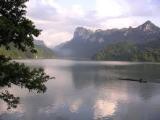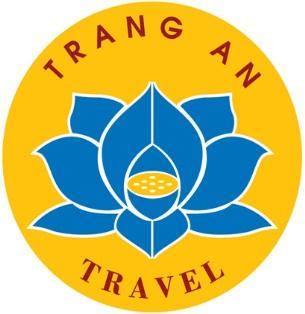Ba Be Lake and National Park

Ba Be is Vietnam’s largest natural lake and is now the centrepiece of an extensive National Park. The park and the surrounding area is limestone country, so lakes, waterfalls, caves and unusual rock formations abound. The whole area is richly forested and home to many ethnic minority communities.
The National Park is covered by tropical and semi-tropical evergreen Thailandian monsoon forest. The bio diversity is rich – 50 animal species, over 400 plants and many species of insects, reptiles and birds. The ten seriously endangered animals in the park include two primates, the Black Gibbon and the Tonkinese 'snub-nosed' monkey.
Flat-bottomed boats slide easily across the still waterThe latter is one of the world’s rarest species and on the brink of extinction. Flora and Fauna International is working with the park authorities and other agencies to save this attractive creature.
The lake itself is really three lakes linked by wide channels. Overall, it’s about 7km long and a kilometre across at its widest point, and contains around fifty species of freshwater fish. The surface is nearly always calm, making a boat trip a peaceful experience. In adddition, there are islands and caves to visit.
Horsewomen from a local Tay ethnic minority villageWithin the park’s boundary there are a several small villages inhabited by members of the Tay, Red Dao, Coin Dao and White H’mong ethnic minorities. However, the colourful costumes typical of most of these groups are seldom in evidence apart from performances and demonstrations for tourists.
Some of the villages offer basic, but reasonably comfortable, homestays. An alternative is the park’s guesthouse, which provides basic accommodation only. Elsewhere, there is limited local standard accommodation in Cho Ra town, about 18km away outside the park.
Cycling is a good way to travel around the rough roads and tracksBa Be can only be reached by road - the 250km journey takes between six and eight hours. The road gets rough along the latter part, but the excellent scenery compensates.
An interesting stop en-route is Thai Nguyen, a centre of heavy industry based on steel manufacturing, and the unlikely home of the Museum of Nationalities of Vietnam. It provides an informative overview of the country’s many ethnic minorities, particularly useful for visitors that haven't already visited Hanoi's excellent Ethnology Museum
Paphiopedilum coccineum, a previously unknown orchid specie, was recently discovered in Cao Bang provinceFurther north is Cao Bang province, a remote area on the border with China. Cao Bang is sparsely populated. It has very few large settlements but several ethnic groups in villages hardly affected by tourism.
The limestone ‘karst’ scenery is attractive, unspoilt and fich in bio-diversity. Few visitors venture further north than Ba Be, so Cao Bang vies with the remote northwest as one of the best places to see truly authentic ethnic minority lifestyles.
From Cao Bang, it’s possible to loop round to the south via the border town of Lang Son to Quang Ninh Province and Ha Long Bay. However, the road is poor, and the scenery is not particularly interesting
Flat-bottomed boats slide easily across the still waterThe latter is one of the world’s rarest species and on the brink of extinction. Flora and Fauna International is working with the park authorities and other agencies to save this attractive creature.
The lake itself is really three lakes linked by wide channels. Overall, it’s about 7km long and a kilometre across at its widest point, and contains around fifty species of freshwater fish. The surface is nearly always calm, making a boat trip a peaceful experience. In adddition, there are islands and caves to visit.
Horsewomen from a local Tay ethnic minority villageWithin the park’s boundary there are a several small villages inhabited by members of the Tay, Red Dao, Coin Dao and White H’mong ethnic minorities. However, the colourful costumes typical of most of these groups are seldom in evidence apart from performances and demonstrations for tourists.
Some of the villages offer basic, but reasonably comfortable, homestays. An alternative is the park’s guesthouse, which provides basic accommodation only. Elsewhere, there is limited local standard accommodation in Cho Ra town, about 18km away outside the park.
Cycling is a good way to travel around the rough roads and tracksBa Be can only be reached by road - the 250km journey takes between six and eight hours. The road gets rough along the latter part, but the excellent scenery compensates.
An interesting stop en-route is Thai Nguyen, a centre of heavy industry based on steel manufacturing, and the unlikely home of the Museum of Nationalities of Vietnam. It provides an informative overview of the country’s many ethnic minorities, particularly useful for visitors that haven't already visited Hanoi's excellent Ethnology Museum
Paphiopedilum coccineum, a previously unknown orchid specie, was recently discovered in Cao Bang provinceFurther north is Cao Bang province, a remote area on the border with China. Cao Bang is sparsely populated. It has very few large settlements but several ethnic groups in villages hardly affected by tourism.
The limestone ‘karst’ scenery is attractive, unspoilt and fich in bio-diversity. Few visitors venture further north than Ba Be, so Cao Bang vies with the remote northwest as one of the best places to see truly authentic ethnic minority lifestyles.
From Cao Bang, it’s possible to loop round to the south via the border town of Lang Son to Quang Ninh Province and Ha Long Bay. However, the road is poor, and the scenery is not particularly interesting
Tin tức liên quan
- Vietnamese second most confident in Asia-Pacific about post-pandemic travel: survey (24/6/2022)
- Kayaking in Việt Nam’s most beautiful places (24/04/2021)
- Da Nang tops Google list of 10 trending destinations for 2020
- Explore Vân Long Wetland Nature Reserve in Ninh Bình
- Hà Nội Train Street among Top 8 over-touristed sites (03/12/2019)
- VNAT hosts famtrip to explore sea and island tourism products in Quang Nam and Quang Ngai
- Travel Daily News lists amazing ways to see Viet Nam (21/06/2019)
- Ha Noi serves nearly 14.4 million visitors so far (21/06/2019)
- CNN praises Hoi An as one of the most beautiful towns in Southeast Asia (19/06/2019)
- Quang Ninh has additional sea and island tourism site (14/06/2019)
Tìm kiếm
Tour
Hotel
Keyword
Location
Location
Star
Type







